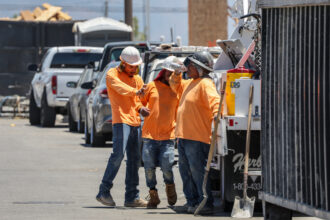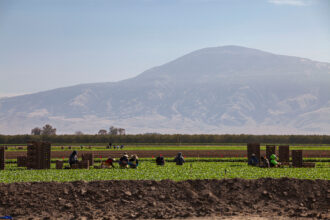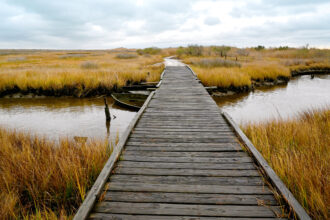The Biden administration finally proposed federal heat protection standards last week, more than half a century after federal experts first outlined the need for such rules.
The Nixon administration proposed detailed recommendations to safeguard workers in hot environments in 1972, a few years after Congress established the National Institute for Occupational Safety and Health, or NIOSH, tasked with research and training on heat illness, and the Occupational Safety and Health Administration, or OSHA, charged with enforcing standards.
The 1972 NIOSH report warned that high heat can cause accidents on the job and exacerbate the harms of toxic exposure, citing multiple reports, including a 1928 study of coal miners showing higher rates of sickness and death in hotter mines.
“Increased bodily temperature and discomfort increase irritation, anger and other emotional states which may induce workers to commit rash acts or divert attention from hazardous tasks,” the report noted, “setting the stage for accidents.”
Yet OSHA waited two generations to act, even as advocates urged the agency to implement a federal occupational heat safety standard and the consequences of its delay mounted. Between 1992 and 2019, more than 900 workers died from extreme heat on the job, and tens of thousands became ill.
Members of Congress tried several times to require OSHA to develop enforceable heat standards but met stiff corporate opposition, wrote Juanita Constible, an environmental and climate health expert who tracks heat policy for the nonprofit Natural Resources Defense Council, in the group’s Feeling the Heat report in 2022.
“We are in the midst of a profound public health crisis,” Constible warned. “Workers face a range of climate-related hazards on the job, but one of the most pressing and well-understood hazards is extreme heat.”
Meanwhile, scientists continue to document heat’s deadly effects. Fine particles interact with high heat to double the risk of fatal heart attacks compared with either exposure in isolation, a study in China published last year showed. And a 2021 study of more than 11 million California workers’ compensation claims showed that high heat caused about 20,000 injuries a year.
Official reports of heat-related illness and death routinely underestimate heat’s true toll, partly due to underreporting by employers, workers’ fear of retaliation if they complain and medical examiners’ failure to recognize the signs of heat stress.
Even California, which passed the country’s first outdoor heat rule, may be undercounting heat deaths, an Inside Climate News investigation published last year found. California OSHA (Cal/OSHA) reported two farmworker deaths from heat exposure between 2018 and 2022. But the ICN investigation identified scores of workers who died during that time of conditions associated with increased risk of death due to heat stress, including accidents and cardiovascular and respiratory conditions. All were working in polluted air when temperatures exceeded 80 degrees Fahrenheit, the trigger for the state’s heat standard.
Heat-related fatalities, injuries and illnesses are preventable, Constible wrote in Feeling the Heat, “but current federal regulations do not support prevention.”
Inside Climate News spoke with Constible about the long road to getting a standard in place and what’s needed to make sure workers get the strong, comprehensive heat protections needed to keep them safe and healthy. The conversation has been lightly edited for length and clarity.
The Biden administration finally proposed the heat standard the president promised at the beginning of his term, while climate change has made the frequency and severity of extreme heat episodes increasingly deadly. Why has it taken so long for this life-saving proposal to see the light of day?
Unfortunately, OSHA has an awful lot of roadblocks when it comes to making rules. And most of those roadblocks have been imposed in previous sessions of Congresss and by previous presidents. In the broad sweep of federal agencies, it’s hard to point to another rulemaking agency that has as many steps to follow as OSHA. The other problem is that the data on the health impacts of heat are not great. There are underestimates in most of the federal and state databases. And the seemingly low numbers, I think, was a challenge for previous OSHA administrators to say, “Yeah, this is really a problem we need to deal with.”
What are the primary reasons heat-related deaths are misclassified? And what needs to happen to ensure that officials get more reliable figures?

That’s a great question. Part of the problem is that heat deaths and illnesses often look like something else. If someone dies from a heart attack on the job, did they die because they’ve been eating cholesterol all their lives or had other predisposing factors? Or was it because it was really, really hot? It takes a lot of investigation and careful consideration of circumstances to figure that out.
Also, people are often reluctant to report more mild heat-related illnesses, either because of workplace culture or because they’re afraid of retaliation or because they have a financial incentive to just keep going because they’re not making much money in the first place. There’s also a lot of underreporting of occupational health and safety data in general by employers.
Then finally, there are actually quite a few industries or parts of industries that are exempted from the reporting process. A perfect example is smaller farms. Although they’re supposed to report serious illnesses, there’s very little enforcement of smaller operations in general because of, again, rules that Congress has put into place.
What does the proposed standard get right, in your view? And what does it need to improve on?
It’s clear that OSHA was listening to what workers say they need, which is important. The people doing the most dangerous, the hottest work, often know the best way to keep themselves safe, like with paid cooldown periods. If a worker is not going to get money for taking a 15-minute proactive cooldown break, they’re probably not going to take it, especially if they’re a low-wage worker, and that definitely includes farmworkers.
There’s also a requirement to make sure training is in appropriate languages and literacy levels. A lot of our migrant farmworkers have low English proficiency. A lot of them don’t even speak Spanish—they speak languages that don’t have a written form. So making sure they actually understand the training that’s being delivered is critical.
The draft rule is also structured to help forestall the kinds of tragedies that have resulted from failures to properly identify heat emergencies and promptly treat them. There’s an example from a couple years ago that I cannot shake. A construction worker in Texas died from heatstroke after his supervisor thought he was taking illicit drugs and instructed a co-worker to call the cops instead of an ambulance. That delay in treatment probably cost him his life.
Among the things I would like to see strengthened is more detailed language on how to protect temp workers and part-time workers. So, for example, there’s some language about helping workers get used to working in the heat. Unfortunately, the way it’s structured right now, it’s not super clear what it means for people who only work a partial week. Another example is at the lower temperature triggers, workers are encouraged and allowed to take breaks. But even a heat index of 85 degrees, which falls in that lower temperature trigger, can be deadly if workers are doing really strenuous work or they’re wearing protective gear. It’s not enough in workplaces that have intimidating power dynamics, like we see in agricultural work, to just tell workers, “It’s totally fine to take a break.” It’s much better to have a structured schedule for making sure workers are cooling off.
In your 2022 report, Feeling the Heat, you found that nearly 40 percent of Cal/OSHA unprogrammed inspections stem from complaints. Aside from the language barriers you mentioned, the majority of California farmworkers are undocumented and live in daily fear of being deported. That makes them far less likely to complain about poor working conditions. Are there any provisions in the proposed standard to ensure undocumented workers not only receive warnings in their language but also have protections against being deported?
The proposal does direct employers to include anti-retaliation training in their heat training, and to ensure that workers are aware of their right to take breaks and drink water and not to have to pay for any of those things. But those pieces are still going to be harder than some of the other pieces to enforce, where it gets into a he-said, she-said thing, and employers might say, “Oh, we told them their rights.”
I think this is where worker centers and unions and nonprofits that help farmworkers are unfortunately going to continue to be important, not just in California, but across the country because OSHA has an inspector problem. It really just doesn’t have enough people to get the job done. That’s part of the reason that in California and the rest of the country, enforcement relies so heavily on complaints.
The good news is there are several groups that have finally realized they should be using the OSHA complaint system much more. There are efforts to train farmworkers and others all across the country right now to lodge complaints and to know what they have to include in that complaint to be taken seriously. But that still gets us back to the problem of not enough inspectors. If they’re flooded with complaints, and they can’t keep up with them, then workers will still fall through the cracks.
California was the first state to enact outdoor heat standards, and only last month passed an indoor heat standard. Yet even with a long-standing outdoor heat standard, workers are dying in the fields. What needs to be done to facilitate better enforcement beyond forcing community-based organizations and unions to act as watchdogs?
Congress and the states need to fund OSHA appropriately to ensure adequate staffing. And there needs to be more of an emphasis on hiring bilingual inspectors. There’s a lot of distrust of OSHA among farmworker communities because of the language barrier. And because, from their perspective, it often seems like OSHA and the growers are very buddy-buddy. They’re concerned that inspectors are just relaying information from the workers back to the employers and potentially getting them into trouble. A lot more outreach that has to happen, but OSHA just can’t do that on its current budget. It needs more funding from Congress.
Mounting research shows that exposure to heat and air pollution, particularly PM2.5, is a deadly combination. And last year, Inside Climate News published an investigation of heat deaths among agricultural workers in California that found that scores more workers were dying in hot polluted air than official OSHA records reported. Does the proposed standard follow evidence-based practices to prevent heat-related illness in light of this current research?
It doesn’t take the air quality double whammy into effect. That’s tricky. Since that research is pretty new, it’s harder for OSHA to defend it. But there are certainly plenty of other evidence-based standards. A perfect example of that is directing employers to ensure that any worker having a heat emergency gets cooling before emergency responders show up.
One of the things we know about heatstroke is that it’s critical to bring down the body temperature as soon as possible to ensure better outcomes, not just survival, but also preventing long-term disability that can result from brain damage or damage to other organs. That’s certainly one situation in which OSHA is right there with the medical literature and saying this is the best practice for dealing with a heat emergency. The science will always evolve. But from all that I’ve seen, OSHA has been carefully paying attention to what the literature says, across the board.
The day after New Year’s 2023, a young farmworker died in the heat on his first day on the job in Florida. The early days on the job, before a worker can get used to the heat, are the most dangerous. Two other workers died of heat-related illness in Florida that year as well. But DeSantis banned local governments from establishing heat protections for outdoor workers earlier this year. Texas passed a similar measure last year. How would a federal standard supersede such draconian laws? And how quickly do you think this proposal will turn into action?
We’re probably looking at another two to three years before we see a final federal standard. That’s why it’s really critical for states to keep working on standards if they have them under way.
Plus, the original law that authorizes OSHA covers only private sector workers. If states develop their own federally approved state plan that’s just as good as the federal rules, then state and local government workers are covered under the state plans. States have a much quicker ability to set their own standards.They can go above and beyond the federal rule, they just can’t go under it. But if you go above and beyond it, you do your own enforcement. That’s why Cal/OSHA exists as a separate entity and where most of the enforcement happens in California.
In what are called “federal OSHA states,” like Texas and Florida, they’ve said the federal government should be the ones setting the standards. So hypothetically, at least, they’re on board with federal OSHA doing their own standard. But state and local government workers in states that do not have a federally approved state plan will not be covered by the proposed standard.
OSHA was throwing around a figure that 36 million workers in the country fall under the new rule. But that’s not all our workers by any stretch. There are a lot of holes. Beyond state and local workers, independent contractors aren’t covered or most indoor workers in air-conditioned spaces. And we know there’s going to be litigation from all corners, probably including from some state governments.
This story is funded by readers like you.
Our nonprofit newsroom provides award-winning climate coverage free of charge and advertising. We rely on donations from readers like you to keep going. Please donate now to support our work.
Donate NowAre there aspects of heat-related illness that employers and policymakers routinely misunderstand?
One of the misconceptions is that heat illness is not that serious. It’s true that most people who get a heat-related illness do not die of heatstroke or kidney disease, for example. But heat can go from a mild problem to a deadly problem in the space of half an hour under the wrong conditions.
And older folks who think of the summers of their youth don’t recognize how much more severe our summers have gotten. So they rely on their earlier experience of working in the heat. But heat is getting worse, and it’s getting deadlier and we haven’t been keeping up with the times when it comes to protecting workers.
California is in the middle of an excessive heat warning and most states are on track for another hotter-than-normal summer. What is the single most important thing employers and regulators like OSHA should do to ensure that no one dies of a preventable heat-related illness on the job?
It comes back to the basics of rest, water and shade. It sounds trite but if you keep people hydrated, if you give them a chance to regroup and bring their body temperature down, and make sure the place that they have to do that regrouping is not a hot school bus in the middle of a field, that in itself will save a lot of lives.
About This Story
Perhaps you noticed: This story, like all the news we publish, is free to read. That’s because Inside Climate News is a 501c3 nonprofit organization. We do not charge a subscription fee, lock our news behind a paywall, or clutter our website with ads. We make our news on climate and the environment freely available to you and anyone who wants it.
That’s not all. We also share our news for free with scores of other media organizations around the country. Many of them can’t afford to do environmental journalism of their own. We’ve built bureaus from coast to coast to report local stories, collaborate with local newsrooms and co-publish articles so that this vital work is shared as widely as possible.
Two of us launched ICN in 2007. Six years later we earned a Pulitzer Prize for National Reporting, and now we run the oldest and largest dedicated climate newsroom in the nation. We tell the story in all its complexity. We hold polluters accountable. We expose environmental injustice. We debunk misinformation. We scrutinize solutions and inspire action.
Donations from readers like you fund every aspect of what we do. If you don’t already, will you support our ongoing work, our reporting on the biggest crisis facing our planet, and help us reach even more readers in more places?
Please take a moment to make a tax-deductible donation. Every one of them makes a difference.
Thank you,














